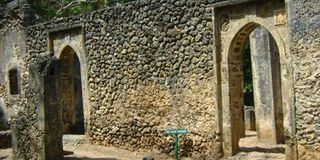Lost town of Gedi is about beauty in all its splendour

Part of Gedi Ruins that is managed by the National Museums of Kenya. FILE PHOTO
What you need to know:
- Ruins now managed by National Museums of Kenya.
- Area is home to threatened birds and sustains some 250 butterfly species.
Cast your mind 700 years back and think of a wonderful walled town at the edge of the Indian Ocean, well planned with finely crafted stone buildings.
Add to this majestic mosques, palaces, mansions, tombs, an elaborate drainage system, running water, flush toilets and bathtubs.
Its prosperous residents were cultured with refined taste and a penchant for luxurious living.
That is Gedi, located in Kilifi County, 16 kilometres south of Malindi, near Watamu and its world famous beach.
Spreading over 45 acres, Gedi was an important Swahili settlement along the East African coast.
It thrived between the 12th and 18th centuries before its inhabitants mysteriously deserted it, leaving it to decay.
The reasons for its decline are blurred. Historians postulate that it was the persistent attacks by the nomadic Galla from Somalia or lack of water due to the drying up of the wells, or both.
In the ensuing years, nature took over, leaving behind evocative ruins amid a magnificent indigenous forest that is home to Guegon monkeys and a large variety of bird life.
Besides, the site is sacred for traditional rituals and sacrifices.
Gedi is now managed by National Museums of Kenya. The friendly, well-informed guides are always there to educate visitors about the Grand Mosque, the palace with sections for men and women and the eight-sided pillars of tombs with Arabic dates and inscriptions.
Adjacent to the ruins is the community-managed Kipepeo Butterfly Project with a splendid Butterfly House that markets pupae farmed by locals who live around the Arabuko-Sokoke Forest, the largest single block of natural coastal rainforest remaining in East Africa.
It is home to globally threatened birds and mammals and sustains some 250 butterfly species. Kipepeo is the first of its kind in Africa and a beacon of success.
Watamu has a lot more to offer — the Bio-Ken Snake Park and Watamu Turtle Watch. Not too far off is the Mida Creek famous for its exceptional birdlife.
All the places are easily accessible and well served by public transport.
Do you know of a place that captures the beauty, warmth and the distilled essence of our country? Can you write crisply and take captivating pictures? Send your write-up and pictures to [email protected]




